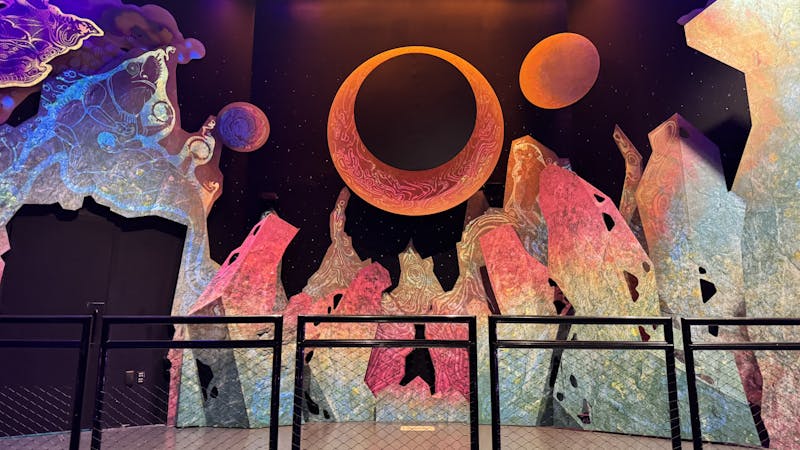With ‘Practices of Attention,’ Rice students explore capitalist ruins

Angela Chen’s photo-textile collage titled “Practices of Attention” is currently on display at the Moody Center for the Arts’ Project Wall. Hadley Medlock / Thresher
Anyone who has walked through Sewall Hall in the past couple months has inevitably seen the words “ARTS 477: Practices of Attention in Capitalist Ruins” written in big, bold lettering on flyers displayed throughout the building. The class is part of a larger project associated with the Moody Project Wall piece “Practices of Attention” envisioned by Angela Chen, a lecturer of art in Rice’s Department of Art.
Launched in 2021, the Moody Project Wall series brings together Houston-based artists and Rice students for collaborative art pieces. Molly Everett, an assistant curator at the Moody Center for the Arts, says that collaboration with students is at the heart of these projects.
Uniquely, this latest work in the Moody Project Wall series is being incorporated into a class taught by Angela Chen, a Rice lecturer who specializes in photography. Everett explained how Chen’s class is focused on encouraging students to pay attention to their environment, both within Rice and beyond.
“I think one of the really interesting things about Angela’s project is also that it’s very much engaged in the landscape around Rice but also with the community more broadly, so [the class is] doing a lot of field trips as part of this project,” Everett said.
The starting point of the project is Angela Chen’s own work “Practices of Attention,” a piece currently on display in the Moody Flex Space. “Practices of Attention” is a large-scale, photo-textile collage that consists of images of the Buffalo Bayou as its surroundings become more industrial as it moves west to east.
“[The piece] will sort of work as an anchor then for the students … and they’ll use that almost as a sort of jumping off point and then the rest of the wall is for them to contribute their work,” Angela Chen said.
According to Angela Chen, she wanted her work to illustrate the disparities that exist around the Buffalo Bayou’s banks and call attention to the environmental damage and health risks that are occurring in its vicinity.
“As you go from West to East the pollution becomes way worse because the eastern portion of Buffalo Bayou is all refineries, there’s petrochemical industry, there’s fertilizer plants, gypsum plants, the air quality is way worse,” Angela Chen said. “Amnesty International just declared the Houston ship channel a ‘sacrifice zone’ this past month in January because it’s just so polluted there.”
Her work represents the central goal of the class: encouraging her students to focus on and ask questions about the environment around them with the purpose of highlighting ecological issues facing the world today.
“How do we slow down and really appreciate where we are, learn how to see and care for our environment through paying attention?” Angela Chen said. “The prompt for these project proposals was basically, ‘What do you want to pay attention to?’ and ‘What are the environmental stakes of this question, and how is paying attention going to help us address issues around climate crisis?’”
Kevin Chen, one of the students in ARTS 477, said the class emphasizes experiencing the environment firsthand and, in it, he’s personally visualized the way capitalism influences ecology.
“It’s very hands-on, it’s very experiential … We had one class where we worked with found clay behind the Moody, we went to the Baytown Nature Preserve last week to kind of see firsthand the presence of a nature preserve right next to these major oil refineries and what that means and the interaction between [them],” Kevin Chen, a Sid Richardson College senior, said.
Kevin Chen said that he eventually hopes his own project proposal will allow him to be a “practitioner of attention.”
“I’m focusing on the drainage system pipes in Houston … I work in photography so I’m planning to go to different sites in Houston and use imagery to depict those places with pipes and kind of depict the type of people there or the objects or the things in the environment,” Kevin Chen said.
While the class is offered by the Department of Art, it brings together a diverse group of students with varying backgrounds.
“It’s a very multidisciplinary class, a lot of the students in the class are art majors like me but … there’s just a variety of different disciplines that people are interested, and we’re all kind of tied together by our common interest in the capitalistic influences that can result changes in our society with regards to the climate, with regards to ecological change,” Kevin Chen said.
Their work is set to be finished by April 19, when the finished piece, complete with projects from each of the seven students in the class, will be displayed at an exhibition from 5 p.m. to 7 p.m. in the Moody Center for the Arts.
More from The Rice Thresher

Thresher’s guide to arts and entertainment in Houston
New to the city? Unsure how to spend your time procrastinating on homework? You’re in luck — Houston is a playground if you know where to look, and most of it is an easy metro ride or short commute from campus. Here’s a starter pack of spots that deliver fresh air, brain food and the occasional “wait, this is in Houston?” moment.

Thresher’s Lollapalooza report: Who ruled Grant Park?
Chicago’s Grant Park ran on pure dopamine this weekend — surprise debuts, late-but-worth-it arrivals, confetti, fireworks and at least three mass sing-alongs an hour. From Joey Valence & BRAE road-testing new indietronica to A$AP Rocky cracking open his vault, T-Pain turning the field into karaoke and Olivia Rodrigo summoning Weezer, Lollapalooza felt like a live-wire mixtape. Doechii built a universe, TWICE made history and Sabrina signed off with a superstar-cementing finale. Here’s what actually lived up to the skyline.
“Ginny & Georgia” Season 3: A Messy, Magnetic Villain Origin Story
I’ll admit it: I came into “Ginny & Georgia” expecting another glossy Netflix soap that looks great in a weekend binge but evaporates from memory by Monday. By the end of season three, I realized I’d been doing something I rarely do with shows like this: I was taking notes. Not on the plot (though it’s as twisty and outrageous as ever), but on the characters. I loved them. I was grinning from ear to ear watching them scheme, stumble and monologue their way through impossible situations. That’s when I knew: this show had done something right.


Please note All comments are eligible for publication by The Rice Thresher.